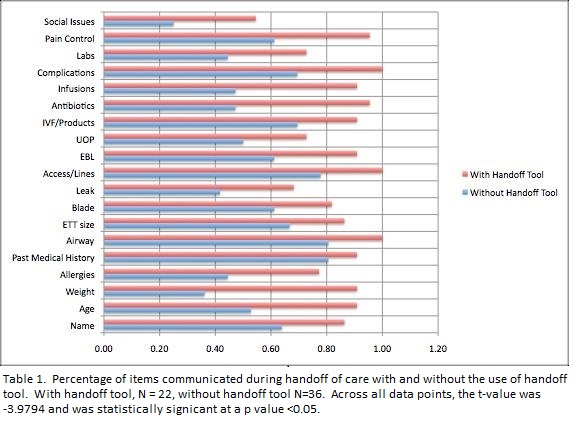NM-261
Improving Communication with the use of an EMR generated checklist
Than K, Patel N
Children's Hospital Los Angeles, Pasadena, CA, USA
Introduction
The handoff of pediatric patients to the intensive care unit following surgery is a critical process during a vulnerable time. Ineffective communication can lead to preventable errors and adverse outcomes. The Joint Commission and ACGME have made handoff communication a national patient safety goal. Many standardized tools exist but the best process has not been identified. An ideal handoff would include accurate, up-to-date information with decreased cognitive load on the provider. In our institution we developed a computerized handoff tool. We hypothesized that a computerized standardized checklist would improve communication from the operating room to the ICU.
Methods
This was a prospective, observational study that assessed the communication of nineteen data points of pediatric patients from the OR to ICU. Data was collected by a non-participating observer. Our primary outcome was to measure the effectiveness in communication during handoff of care from the OR to the intensive care unit (ICU) and our secondary outcome was to compare different methods of communication. The different methods of communication included the absence of a checklist, a laminated card checklist or a checklist form generated by our electronic medical record (EMR). Data was analyzed using a t-test with a 0.95 confidence interval.
Results
There were a total of 58 handoffs observed, see table for details. The use of a checklist had a statistically significant improvement in communication. The use of a computerized handoff checklist improved compliance with the use of a checklist.
Discussion
Effective handoffs are crucial to the safe care of patients during transition of care. In our study, the use of a standardized handoff tool improved communication of important information from the operating room to the ICU. This can potentially avoid adverse outcomes. We found that utilizing an EMR system to facilitate handoff of care improved communication and compliance with the use of a checklist.
Conclusion
A computerized standard handoff tool improved communication from the OR to the ICU and improved compliance of the use of a checklist for handoff of patient care.
References
Arora, V. and Johnson, J., A model for building a standardized hand-off protocol., Joint Commission Journal on Quality and Patient Safety. Nov 2006, 32:11, 646-655.
Bigham, M., et al., Decreasing handoff-related care failures in Children’s Hospitals. Pediatrics. August 2014,134:2, e572-79.
Catchpole, K., et al., Patient handover from surgery to intensive care: using Formula 1 pit-stop and aviation models to improve safety and quality. Pediatric Anesthesia, 2007, 17:470-478.
Kaufman, J., et al. A handoff protocol from the cardiovascular operating room to the cardiac ICU is associated with improvements in care beyond the immediate post-operative period. The Joint Commission Journal on Quality and Patient Safety. July 2013, 39:7, 306-311.
Top












